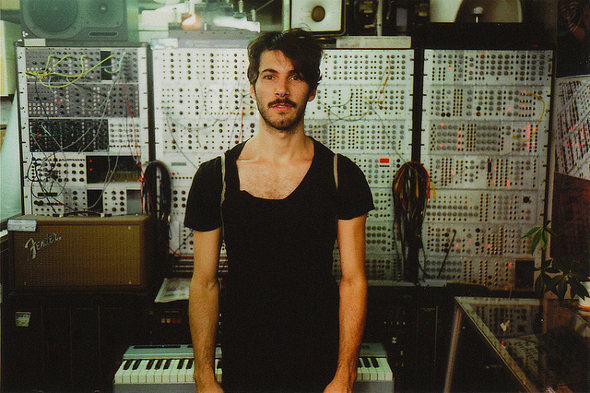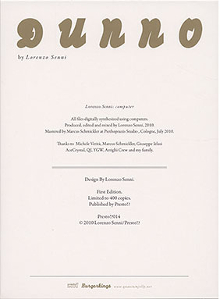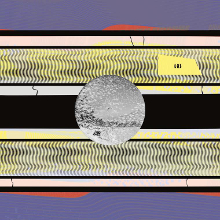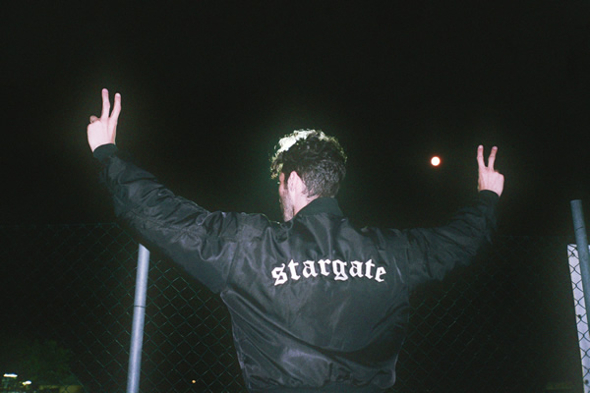Lorenzo Senni: In High Places

Ahead of his appearance at this year’s Unsound festival, Scott Wilson talks to Milan-based artist Lorenzo Senni about the surprising directions he’s taking with his deconstructed form of trance.
At last year’s Donaufestival in Austria, Milan-based artist Lorenzo Senni was booked to perform a set of material from his 2012 Editions Mego album Quantum Jelly. A record that deconstructed the trance genre by configuring its building blocks into hypnotic sawtooth spirals, it exposed the inner workings of one of dance music’s most maligned genres and tinkered with them like an obsessed watchmaker. As Senni finished his set with a simple new three-chord track, someone in the audience began to sing. It was Tom Krell, whose R&B-influenced music as How To Dress Well couldn’t seem to come from a more different place than Senni’s academically-influenced approach. “I looked up and thought ‘fuck.’ It was Tom, in the middle of the crowd, seven metres from the stage, improvising,” Senni recalls.
Rather than feeling uncomfortable at Krell’s impromptu performance, Senni ended up collaborating on two tracks with Krell on his recent album What Is This Heart?. It may seem unusual that an artist who creates what he calls “pointillistic trance” would end up working with Krell, but there’s undoubtedly something about Senni’s approach that straddles a line between the worlds of avant-garde and pop. His recent Superimpositions LP for Boomkat Editions saw the same trance signifiers moulded into more accessible shapes, while his Presto!? label has released music from conceptual pop artists like Gatekeeper and Palmistry alongside that of Evol and Florian Hecker. He even counts Tri Angle artist and Kanye West producer Evian Christ among his admirers. “In a way I’m fighting every day with these things,” Senni tells me over Skype from the makeshift studio set up in a utility room in his Milan apartment, where a washing machine and synthesisers occupy the same space. “My influences and my background, and also my more pop side. I’m fighting this every day, and this puts me in two different worlds.”

It seems as if Senni is a man who has always been caught between two worlds in one way or another. As a teenager in the small town of Cesena, Senni divided his free time between playing in a hardcore punk band and taking the short trip to clubs in Rimini with another group of friends into hard trance and gabber. When he went on to study a Musicology degree at the University of Bologna several years later, his frustration at the syllabus led him to find inspiration in the music of granular synthesis pioneer Curtis Roads, as well as similarly challenging artists like Florian Hecker, Aphex Twin and Russell Haswell. Nowadays, he finds his time divided between making his own music, and working with brands on music for adverts as well as working on music for film and theatre.
However, it’s Senni’s dual relationship with experimental music and a more experimental type of pop that seems to define him these days. Though he had dreams of creating a live synth band as a teenager, he took his first serious steps into creating electronic music through the visual programming language MAX/MSP, his earliest compositions rich in the kind of sharp digital tones and occasional blasts of noise favoured by those he took inspiration from. The non real-time methods Senni used were painstaking and laborious, and the structures abstract, but Dunno, his second album, even seemed to have a bit of that pop structure. Senni recalls the first time he met Giorgio Mortari, art director of forward-looking Italian festival Dissonanze, who told Senni of his admiration for Dunno and that he felt he had “a pop attitude.” It’s something Senni has started to come round to, mentioning the Dunno track “In High Places” as a bridge between his early music and his current direction. “Now I think I understand what he was talking about,” he says. “That’s my father’s fault, a car mechanic, music enthusiast, listening to Battisti & Battiato on loop.”

With John Hudak, Lawrence English and Evol among its early artists, Senni’s Presto!? offers him another avenue to explore these interests. The label was launched shortly after he left university in 2008 as a way to explore his love of complex computer music. As time has progressed Senni’s tastes have broadened and the label has since evolved into quite a different entity. Alongside the label’s more academic focus, a new strand has begun to emerge. It’s one with more in tune with a high-concept form of pop music, so far releasing music from Triad God producer Palmistry, and Gatekeeper, whose Young Chronos was released as a torrent on The Pirate Bay. “I feel very free, because Presto!? is not about a business thing or a very straight line I draw, “Senni explains. “Sometimes, honestly, I’m really jealous of labels that can follow one very precise thing and go deep in that way – I really respect this kind of thing, but I can’t do it.”
Part of this diversification arguably came from events that occurred after making firm friends with Simone Trabucchi, whose stewardship of the Hundebiss label has seen him release music from James Ferraro, Hype Williams and Aaron Dilloway among others. Shortly after Presto!? was started, Senni received an invitation from Trabucchi to live in the abandoned offices of a factory in Milan. “It was a great chance to move out from Cesena,” Senni recalls, “because at that time Presto had just started, and I was doing everything through the computer because I was outside the real world. I never met the people I was releasing the records by, so it was a good chance to move to a bigger city where I knew some people from the Italian music scene.”
The space had been given to Trabucchi by a benevolent art collector from the city, and he began to hold underground parties, hosting the likes of Kode9, Stellar OM Source and Emeralds. “It was in the basement of the building,” Senni recalls, “in the place where the people who previously worked there could have a shower after work, so it was also a bit of a strange place. At the beginning the parties were very small, but then became popular in Milan in an underground way – maybe 200 people. The good thing was the people from Milan were coming there to discover things, and not party, because in Milan ‘partying’ is very fancy – that was not fancy – but it was not a squat, not like a punk context. So it was a good place to discover things. It was very free but worked very well because Simone had total control over the situation. Illegal but controlled.”

The position Senni found himself as part of the space – named Arrighi – allowed his label to grow, inviting artists like Evol to play, and making his records visible at the Hundebiss parties. Eventually people in Milan began to become more familiar with Senni and Presto!?. Despite this, it wasn’t until Senni released Quantum Jelly on Editions Mego in 2012 that he started to become more widely recognised outside of Milan and smaller experimental circles. It was arguably the unique concept behind the record – the deconstruction of trance music – that caught the attention of many. “My idea came listening back to trance tracks I heard when I was very young, and wasn’t conscious of listening to properly. And listening to the tracks, what I found very interesting, very important, was the build-up in the song structure,” Senni explains. “I started to collect build-ups like a serial killer does with photographs of his victims. I started to buy a lot of records, trance compilations, asked my old friends for records and advice, and then I started to cut the build-ups out and put them in a folder, to analyse and have a clearer view of what was happening inside of this musical thing.”
Rather than the misty-eyed nostalgia for rave and jungle explored in recent years by artists like Leyland Kirby, Lee Gamble and countless others, Senni’s obsession was structural, wanting to “dry out” a lot of the genre’s unnecessary musical ornaments, and hone in on how emotion could be gleaned from the precision intervals and harmonics of the seven sawtooth waves of the Roland JP-8000 synthesiser by playing with the rules of the genre. “My idea – if the standard build-up goes from 0-100 per cent, I think my build-ups are going from 65-80 per cent,” he explains. “In terms of progression – and this was very important, because the build-up, the melody thing, the sound texture in itself are already uplifting, so I didn’t want to push too much in that direction. I wanted to keep it building up, without flying too high.”
Preserving the tension of the build-up in a temporal stasis, Senni’s Quantum Jelly compositions pulled the emotional heart strings in a more introspective way. Freed of nostalgia, they asked the listener to engage with the present rather than the past. Despite this, his past as a teenage raver still had its part to play. “Even if I discovered most of this music afterwards, when I started working on Quantum Jelly – to have had been in the clubs, in an environment where my friends at school were all dressing gabber or wearing Buffalo on their feet was maybe important for me to create the opposite reaction,” Senni explains. “I was trying to be opposed to the melancholia, and the idea of how good the past times were. Quantum Jelly was a reaction to that.”
 It’s something Senni has continued to explore in Superimpositions, his recent LP for Boomkat Editions, a record the Italian agrees is more accessible than the occasionally challenging Quantum Jelly. It features the same palette of trance sounds, but while his last record largely looked inwards, Superimpositions feels like a more joyful set; “Happic” coils itself to the point you feel it might start shaking off neon sparks, “Elegant, But Never Tiring” rolls around in a bubble of chemically-induced bliss while “Superimposition” is pretty much hard trance without the beats. The self-referencing “Pointillistic T*****” even sounds as if it could be the backing to a rap track with the right vocalist. More importantly, unlike Quantum Jelly, each track feels like a more distinct entity, each taking his recognisable signature into new places. “It’s because these tracks are actually the result of a very stressful selection of music made post-Quantum Jelly,” Senni explains. “Quantum Jelly is not a masterpiece but it’s still one thing. It’s a real stamp, a very recognisable style, so if I wanted, I could do another five records the same way, because after the process of conceptualising it, and of making it, it’s very simple for me to make another one. What I wanted to do post-Quantum Jelly was explore other directions of where it can go. This is a collection of direction I think.”
It’s something Senni has continued to explore in Superimpositions, his recent LP for Boomkat Editions, a record the Italian agrees is more accessible than the occasionally challenging Quantum Jelly. It features the same palette of trance sounds, but while his last record largely looked inwards, Superimpositions feels like a more joyful set; “Happic” coils itself to the point you feel it might start shaking off neon sparks, “Elegant, But Never Tiring” rolls around in a bubble of chemically-induced bliss while “Superimposition” is pretty much hard trance without the beats. The self-referencing “Pointillistic T*****” even sounds as if it could be the backing to a rap track with the right vocalist. More importantly, unlike Quantum Jelly, each track feels like a more distinct entity, each taking his recognisable signature into new places. “It’s because these tracks are actually the result of a very stressful selection of music made post-Quantum Jelly,” Senni explains. “Quantum Jelly is not a masterpiece but it’s still one thing. It’s a real stamp, a very recognisable style, so if I wanted, I could do another five records the same way, because after the process of conceptualising it, and of making it, it’s very simple for me to make another one. What I wanted to do post-Quantum Jelly was explore other directions of where it can go. This is a collection of direction I think.”
These different directions are influenced by Senni’s other projects, in which abstract song structures are clearly present. He’s part of One Circle with fellow Italian artists Vaghe Stelle and A:RA, whose experience in creating emotive synth music and film soundtracks respectively combine with Senni’s approach to create soaring genre hybrids somewhere between techno, ambient music and dubstep. Senni’s Stargate project meanwhile operates on a much more lo-fi spectrum; “Driving Hyperreality” combines a trance-like arpeggio with snatches of longing female vocal. “Superimpositions is maybe more accessible because I was experimenting and I was free also to go away from the very brutal concept of Quantum Jelly – to dry out a bit less, try to have different layers of sounds,” he explains. “I’m fighting every day with my other project Stargate that is more poppy, so I found it was also influencing me – some tracks are closer to pop song structure with a kind of chord, verse and chorus.”
 How To Dress Well isn’t the only artist to have picked up Senni’s potential for crafting pop structures. He shares with me that Evian Christ recently found inspiration in Senni’s Quantum Jelly track “XMonsterX”, and that the producer, who uses trance tropes in his own productions, is a fan of his Stargate project. Just as Evian Christ has worked with Kanye West, there are signs that artists from outside experimental circles are starting to see the appeal of his ‘pointillistic trance’ in different contexts. Last year Senni was asked by the UNO label to make a video for d’Eon’s Kalisti project; this led to the label asking Senni to make some material for Mykki Blanco, though Senni admits he’s yet to send anything.
How To Dress Well isn’t the only artist to have picked up Senni’s potential for crafting pop structures. He shares with me that Evian Christ recently found inspiration in Senni’s Quantum Jelly track “XMonsterX”, and that the producer, who uses trance tropes in his own productions, is a fan of his Stargate project. Just as Evian Christ has worked with Kanye West, there are signs that artists from outside experimental circles are starting to see the appeal of his ‘pointillistic trance’ in different contexts. Last year Senni was asked by the UNO label to make a video for d’Eon’s Kalisti project; this led to the label asking Senni to make some material for Mykki Blanco, though Senni admits he’s yet to send anything.
The fact UNO sees Senni’s music as working in a rap context is perhaps unsurprising; there are a few parallels in Senni’s music to be drawn with trance-obsessed producer AraabMuzik, who has worked with A$AP Rocky, Cam’ron and 50 Cent. Senni even admits that he listened to AraabMuzik material during the time he was making Quantum Jelly. Despite his eagerness to work with other artists from outside of his immediate sphere, Senni also shares that making music can be a “struggle,” and creating beats for rappers is an entirely different proposition to laying down toplines. “I can make interesting synth lines maybe, but if they ask me for a beat, I say thank you – this is the wrong person for now. Maybe in 10 years?,” he says with a laugh.
How much of what Senni says in relation to his own abilities is modesty and how much is a genuine awareness of his own limitations is unclear, but it seems a fair bet Senni is heading in a direction nobody could have expected a few years ago. It’s something that doesn’t always sit comfortably with his peers, especially following his work with Krell. “Some people came up to me in Milan, saying ‘I saw you are doing this,’ and they were almost sorry about it. I even get jokes from my friends for doing synths for How To Dress Well – I’m becoming ‘mainstream guy.’ I was like ‘what’s this mainstream? I’m not rich!’ If I’m going to be mainstream I want to be rich!’” he laughs. “But it was actually a great pleasure for me, an honour.”
Where Senni goes from here not even he’s sure of yet, but for the moment he seems to be doing a pretty good job of uniting two very different musical worlds.
Interview by Scott Wilson
Header image by Ilaria Pace, from an image by Piotr Niepsuj.
Lorenzo Senni will be performing at this year’s Unsound festival in Krakow on Tuesday October 14 at the Manggha Centre of Japanese Art and Technology – ticket details for the performance can be found here.